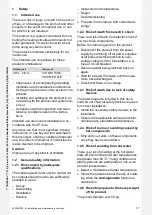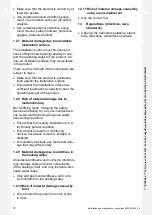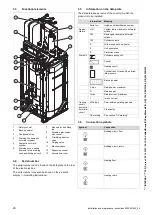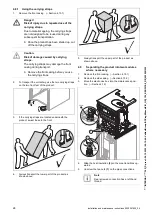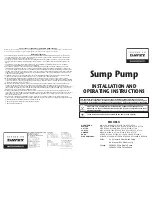
*****INTERNAL*****30 R_D proof- 26.10.2022 / 09:15:46- VaillantGroup\DOC-agt\Brand\VIH_QW_190_6\ENG\OI-II_GB_0020291525
0020291525_04 Installation and maintenance instructions
31
Size of
the outlet
valve
Minimum
diameter
of the
drain pipe
D1
Minimum
diameter
of the
drain pipe
from the
tundish
D2
Maximum
permiss-
ible res-
istance,
inform-
ation
on the
length of
a straight
pipe
Resist-
ance per
elbow or
bend
1/2"
15 mm
22 mm
28 mm
35 mm
9 mm
≤
18 m
≤
27 m
0.8 m
1.0 m
1.4 m
3/4"
22 mm
28 mm
35 mm
42 mm
≤
9 m
≤
18 m
≤
27 m
1.0 m
1.4 m
1.7 m
1"
28 mm
35 mm
42 mm
54 mm
≤
9 m
≤
18 m
≤
27 m
1.4 m
1.7 m
2.3 m
Sample calculation
The following example corresponds to a temperature and
pressure relief valve G1/2 with a drain pipe
(D2)
with four 22
mm elbows and a length of 7 m from the tundish to the drain-
age point. According to the table, the maximum permiss-
ible resistance for a straight length of a 22-mm-thick cop-
per discharge pipe
(D2)
of a thermal expansion relief valve
G1/2 is 9.0 m. The resistance of the four 22 mm elbows,
which are each 0.8 m in length, must be subtracted from this,
i.e. a total of 3.2 m. The maximum permitted length is ac-
cordingly 5.8 m and is therefore below the current length of
7 m. The calculation must therefore be performed using the
second largest size. The maximum permissible resistance
for a straight length of a 28-mm-thick pipe
(D2)
of a thermal
expansion relief valve G1/2 is 18 m. The resistance of the
four 28 mm elbows, which are each 1.0 m in length, must be
subtracted from this, i.e. a total of 4.0 m. The maximum per-
mitted length is accordingly 14 m. As the current length is
7 m, a 28 mm copper pipe
(D2)
should be selected.
Where a single common discharge pipe serves more than
one system, it should be at least one pipe size larger the
largest discharge pipe (D2) to be connected.
A suitable location for the drain pipe terminal is, for example,
beneath a fixed mesh above the odour trap in a soakaway
with a siphon. Low drain pipework, for example up to
100 mm above external surfaces (car parks, meadows, etc.)
can be used provided that it is protected by a wire fence
or something similar to prevent children from coming into
contact with the waste water and provided that the system
is not visible. Do not install any valves or stopcocks on the
drain pipework.
Make sure that the drain pipe from the tundish to the drain
has a constant downward gradient of at least 1:200. The
drain pipe for the heat generator expansion relief valve can
be connected to the horizontal drain pipe for the cylinder
behind the tundish using a T-piece.
The discharge pipe should not be connected to a soil dis-
charge stack unless it can be demonstrated that the soil dis-
charge stack is capable of safety withstanding temperatures
of the water discharged, in which case, it should:
–
contain a mechanical seal, not incorporating a water trap,
which allows water into the branch pipe without allowing
foul air from the drain to be ventilated through the tundish
–
be a seperate branch pipe with no sanitary appliances
connected to it
–
if plastic pipes are used as branch pipes carrying dis-
charge from a safety device, they should be either poly-
butalene or crosslinked polyethylene complying with na-
tional standards as Class S of BS7291-2:2006 or Class S
of BS7291-3:2006 respectively
–
be continuously marked with a warning that no sanitary
appliances should be connected to the pipe.
Note
Plastic pipes should be joined and assembled with
fitting appropriate to the circumstances in which
they are used as set out in BS EN ISO 1043-
1:2002 Plastics. Symbols and abbreviated terms.
Basic polymers and their special characteristics.
Where pipes cannot be connected to the stack it
may be possible to route a dedicated pipe along-
side or in close proximity to the discharge stack.
5.6.3
High-level drain
Installing the highest drain is permitted as long as this does
not present a danger to anyone in or outside the building at
the drain point. Examples of points to consider when decid-
ing whether a location is suitable for the highest drain:
–
The possibility (taking the wind into account) that a per-
son might stay in the area where the water is drained
for a prolonged period of time, and, if this is the case,
whether the water is sufficiently cooled by that point to
pose no danger. The thermal conductivity of the material
surfaces, the climatic conditions, the installation location
and the drain pipework direction can, to different extents,
contribute to reducing the temperature of the water that is
being drained.
–
The position of the windows and other openings.
–
The probability of prams being under the drain opening.
–
The resistance of the surface to hot water.
–
The possibility of ice formation if water drains onto ac-
cess paths.
5.7
Installing the drain pipe on the expansion
relief valve
1.
Install the drain pipe with a continuous downwards
incline in a frost-free environment.
2.
Ensure that the size of the drain pipe corresponds to
the size of the expansion relief valve that has been
checked with the type sample.
3.
Ensure that the drain pipe has a maximum of two el-
bows and a maximum length of 2 m.
4.
Make sure that the end of the pipe is visible.
5.
Terminate the drain pipe in such a way that escaping
water or steam cannot cause injury to persons or dam-
age to electronic components.
6.
Open the expansion relief valve regularly in order to re-
move any scale deposition and ensure that the device
is not blocked.
Содержание uniTOWER plus
Страница 2: ...2 en Operating instructions 3 en Installation and maintenance instructions 15...
Страница 71: ......

